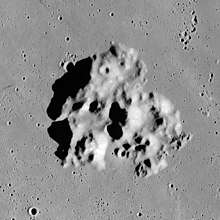Mons Vinogradov
Mons Vinogradov is a rugged massif that is located on the lunar mare where Oceanus Procellarum to the southwest joins Mare Imbrium to the east. There are three primary peaks in this formation, which rise to altitudes of 1.0–1.4 km above the surface. To the east of this rise is the crater Euler, and to the southeast is an area of rugged ground that reaches the Montes Carpatus range. The Carpatus mountain range forms the southwest boundary of the Mare Imbrium.
| Mons Vinogradov | |
|---|---|
 Lunar Orbiter 4 image | |
| Highest point | |
| Elevation | 1.4 km |
| Listing | Lunar mountains |
| Coordinates | 22.4°N 32.4°W |
| Naming | |
| Etymology | Aleksandr P. Vinogradov |
| Geography | |
| Location | the Moon |


The selenographic coordinate of Mons Vinogradov is 22.4 N, 32.4 W, and it has a maximum diameter of 25 km at the base. It was named after Soviet geochemist Aleksandr P. Vinogradov.[1] This mountain was formerly named Euler Beta (β), or Mons Euler.
In the rugged ground just to the southeast of this mountain is a set of craters that have been assigned names by the IAU. These are listed in the table below.
| Crater | Coordinates | Diameter | Name source |
|---|---|---|---|
| Akis | 20.0°N 31.8°W | 2 km | Greek feminine |
| Ango | 20.5°N 32.3°W | 1 km | African masculine |
| Jehan[notes 1] | 20.7°N 31.9°W | 5 km | Turkish feminine |
| Natasha[notes 2] | 20.0°N 31.3°W | 12 km | Russian feminine |
| Rosa | 20.3°N 32.3°W | 1 km | Spanish feminine |
- Notes
- Previously designated Euler K.
- Previously designated Euler P.
References
- "Mons Vinogradov". Gazetteer of Planetary Nomenclature. USGS Astrogeology Research Program.
- Andersson, L. E.; Whitaker, E. A. (1982). NASA Catalogue of Lunar Nomenclature. NASA RP-1097.CS1 maint: ref=harv (link)
- Bussey, B.; Spudis, P. (2004). The Clementine Atlas of the Moon. New York: Cambridge University Press. ISBN 978-0-521-81528-4.CS1 maint: ref=harv (link)
- Cocks, Elijah E.; Cocks, Josiah C. (1995). Who's Who on the Moon: A Biographical Dictionary of Lunar Nomenclature. Tudor Publishers. ISBN 978-0-936389-27-1.CS1 maint: ref=harv (link)
- McDowell, Jonathan (July 15, 2007). "Lunar Nomenclature". Jonathan's Space Report. Retrieved 2007-10-24.CS1 maint: ref=harv (link)
- Menzel, D. H.; Minnaert, M.; Levin, B.; Dollfus, A.; Bell, B. (1971). "Report on Lunar Nomenclature by the Working Group of Commission 17 of the IAU". Space Science Reviews. 12 (2): 136–186. Bibcode:1971SSRv...12..136M. doi:10.1007/BF00171763.CS1 maint: ref=harv (link)
- Moore, Patrick (2001). On the Moon. Sterling Publishing Co. ISBN 978-0-304-35469-6.CS1 maint: ref=harv (link)
- Price, Fred W. (1988). The Moon Observer's Handbook. Cambridge University Press. ISBN 978-0-521-33500-3.CS1 maint: ref=harv (link)
- Rükl, Antonín (1990). Atlas of the Moon. Kalmbach Books. ISBN 978-0-913135-17-4.CS1 maint: ref=harv (link)
- Webb, Rev. T. W. (1962). Celestial Objects for Common Telescopes (6th revision ed.). Dover. ISBN 978-0-486-20917-3.CS1 maint: ref=harv (link)
- Whitaker, Ewen A. (1999). Mapping and Naming the Moon. Cambridge University Press. ISBN 978-0-521-62248-6.CS1 maint: ref=harv (link)
- Wlasuk, Peter T. (2000). Observing the Moon. Springer. ISBN 978-1-85233-193-1.CS1 maint: ref=harv (link)
External links

- LTO-39C2 Mons Vinogradov — L&PI topographic map of mountain and vicinity.
